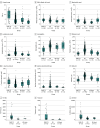Clinical Characteristics of 58 Children With a Pediatric Inflammatory Multisystem Syndrome Temporally Associated With SARS-CoV-2
- PMID: 32511692
- PMCID: PMC7281356
- DOI: 10.1001/jama.2020.10369
Clinical Characteristics of 58 Children With a Pediatric Inflammatory Multisystem Syndrome Temporally Associated With SARS-CoV-2
Abstract
Importance: In communities with high rates of coronavirus disease 2019, reports have emerged of children with an unusual syndrome of fever and inflammation.
Objectives: To describe the clinical and laboratory characteristics of hospitalized children who met criteria for the pediatric inflammatory multisystem syndrome temporally associated with severe acute respiratory syndrome coronavirus 2 (SARS-CoV-2) (PIMS-TS) and compare these characteristics with other pediatric inflammatory disorders.
Design, setting, and participants: Case series of 58 children from 8 hospitals in England admitted between March 23 and May 16, 2020, with persistent fever and laboratory evidence of inflammation meeting published definitions for PIMS-TS. The final date of follow-up was May 22, 2020. Clinical and laboratory characteristics were abstracted by medical record review, and were compared with clinical characteristics of patients with Kawasaki disease (KD) (n = 1132), KD shock syndrome (n = 45), and toxic shock syndrome (n = 37) who had been admitted to hospitals in Europe and the US from 2002 to 2019.
Exposures: Signs and symptoms and laboratory and imaging findings of children who met definitional criteria for PIMS-TS from the UK, the US, and World Health Organization.
Main outcomes and measures: Clinical, laboratory, and imaging characteristics of children meeting definitional criteria for PIMS-TS, and comparison with the characteristics of other pediatric inflammatory disorders.
Results: Fifty-eight children (median age, 9 years [interquartile range {IQR}, 5.7-14]; 20 girls [34%]) were identified who met the criteria for PIMS-TS. Results from SARS-CoV-2 polymerase chain reaction tests were positive in 15 of 58 patients (26%) and SARS-CoV-2 IgG test results were positive in 40 of 46 (87%). In total, 45 of 58 patients (78%) had evidence of current or prior SARS-CoV-2 infection. All children presented with fever and nonspecific symptoms, including vomiting (26/58 [45%]), abdominal pain (31/58 [53%]), and diarrhea (30/58 [52%]). Rash was present in 30 of 58 (52%), and conjunctival injection in 26 of 58 (45%) cases. Laboratory evaluation was consistent with marked inflammation, for example, C-reactive protein (229 mg/L [IQR, 156-338], assessed in 58 of 58) and ferritin (610 μg/L [IQR, 359-1280], assessed in 53 of 58). Of the 58 children, 29 developed shock (with biochemical evidence of myocardial dysfunction) and required inotropic support and fluid resuscitation (including 23/29 [79%] who received mechanical ventilation); 13 met the American Heart Association definition of KD, and 23 had fever and inflammation without features of shock or KD. Eight patients (14%) developed coronary artery dilatation or aneurysm. Comparison of PIMS-TS with KD and with KD shock syndrome showed differences in clinical and laboratory features, including older age (median age, 9 years [IQR, 5.7-14] vs 2.7 years [IQR, 1.4-4.7] and 3.8 years [IQR, 0.2-18], respectively), and greater elevation of inflammatory markers such as C-reactive protein (median, 229 mg/L [IQR 156-338] vs 67 mg/L [IQR, 40-150 mg/L] and 193 mg/L [IQR, 83-237], respectively).
Conclusions and relevance: In this case series of hospitalized children who met criteria for PIMS-TS, there was a wide spectrum of presenting signs and symptoms and disease severity, ranging from fever and inflammation to myocardial injury, shock, and development of coronary artery aneurysms. The comparison with patients with KD and KD shock syndrome provides insights into this syndrome, and suggests this disorder differs from other pediatric inflammatory entities.
Conflict of interest statement
Figures

Comment in
-
SARS-CoV-2-Related Inflammatory Multisystem Syndrome in Children: Different or Shared Etiology and Pathophysiology as Kawasaki Disease?JAMA. 2020 Jul 21;324(3):246-248. doi: 10.1001/jama.2020.10370. JAMA. 2020. PMID: 32511667 No abstract available.
-
Update on the COVID-19-associated inflammatory syndrome in children and adolescents; paediatric inflammatory multisystem syndrome-temporally associated with SARS-CoV-2.J Paediatr Child Health. 2020 Aug;56(8):1173-1177. doi: 10.1111/jpc.15049. Epub 2020 Jul 31. J Paediatr Child Health. 2020. PMID: 32735721 Free PMC article.
References
Publication types
MeSH terms
Supplementary concepts
Grants and funding
LinkOut - more resources
Full Text Sources
Other Literature Sources
Medical
Research Materials
Miscellaneous

